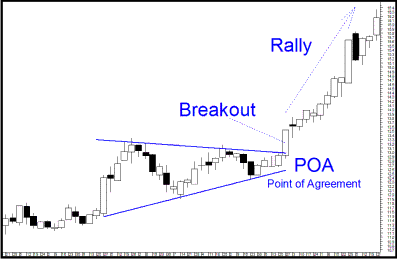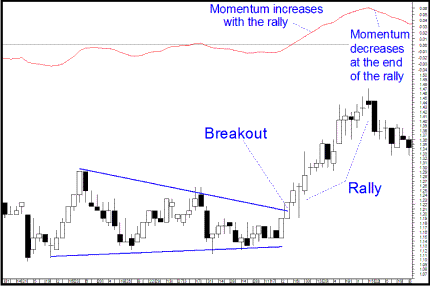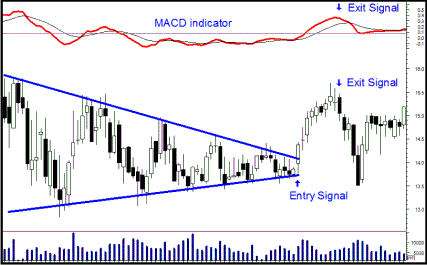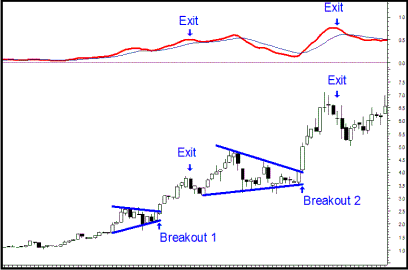- Active Investing - what is it?
- All Weather Trading Plan using Complex Theory (Parts 1 - 4)
- Asset Management (Parts 1 - 4)
- Back Testing
- Breaking out from consolidation
- Breakout trading in all market conditions
- Charting in a Nutshell
- Children of the Bear
- Fibonacci and the Golden Ratio
- Going Public
- Hull Moving Average
- MACD Breakout Trading (Parts 1 - 2)
- Making decisions with a Simple Moving Average
- Probability: do you have the stomach for it?
- Profit Taking
- Relative Strength
- Record Keeping
- Risky Business
- Short Selling
- Social Media Bubble
- Switching Gears
- Rate of Return indicator
- Time and Money
- Tools of the Trade
- Trade Warrants (Parts 1 - 4)
- Trading without spending money
- Trendlines
- Triangles
- GMMA's on Weekly Charts
- Writing Custom Indicators
Articles include:
Finding a trading system that will operate well in all market conditions is the stuff of dreams for many traders. But break out trading, as described here, comes very close to being a system that does exactly that.
You see, many trading systems, such as trend trading systems, are designed to identify a trend and then stay with it until its end. This is a very powerful way to trade - except, of course, when the market is not trending. In difficult market conditions a trend trader often finds few opportunities and can have many false starts. Sometimes they may find themselves sitting on the sidelines trying hard to exercise some patience.
I've had some experience with this because I like trend trading and have several very successful trend trading systems1. Following the rules of these systems means that I will never lose much money but without a trending market it can sometimes be very difficult to move ahead - but this is where break out trading comes to the fore.
Break out trading is essentially momentum trading following a break out from a Point of Agreement; where a Point of Agreement (POA) is a momentary balance in forces on a share price, see chart below.

This works well in all market conditions because of 2 important factors; the entry and exit signals are not based on trending attributes. Rather, the entry for a break out trade is a break out from a Point of Agreement (POA); where a POA is a period of diminishing consolidation or a triangle. Triangles occur in most market conditions but are particularly prevalent in sideways markets - being of a sideways nature themselves.
The exit for a break out trade is based on momentum. This is relevant to break out trading because after a period of consolidation share prices tend to rally; sometimes quite strongly. This increase in the rate of change in price (or momentum) can be monitored using a momentum indicator such as the MACD2. Any weakness in the momentum would signal a slowing of the price and an end of the break out rally.

Thus, putting together a break out trade would look something like that shown in the chart below; where the arrows indicate the entry and exit signals. It is interesting to note that overall the share price in this chart was sideways; no trend developed yet a profitable trade was extracted. This illustrates the beauty of a break out trading strategy and how it can work well in difficult market conditions.

Of course share prices can also consolidate and break out during trends as well. The chart below shows a trending share that had two breakout trades within it. The rallies within the trend were captured. So you can see how break out trading can operate in either a trending or a sideways market. Identify the break out - get into the market quickly and capture profits - and then lock them in with a tight stop loss.

There are other advantages of break out trading besides being an all-terrain trading system. For example, a break out from a Point of Agreement is a high probability trade set up. Recent back testing, based on the break out trading strategy described on my website showed over 60% of trades were profitable. The strategy also has a high profit ratio with an average profit to loss ratio in recent back testing being about 2.3:1.
Furthermore, break outs can be up or down which means that both Long and Short trading opportunities can arise. However, the majority of trades tend to be Long; about 80% in recent back testing, so Short trading opportunities are available but can be overlooked depending on a Trader's preference.
Break out trades exist in many time frames but a weekly time frame is quite robust for trading. This timeframe irons out daily volatility and allows some rallies to develop to very profitable levels. Recent back testing indicates that the average length of a trade using a weekly approach is about 9 weeks. Hence the system is a relatively short term, medium risk strategy.
For a complete set of current back testing results and a full explanation of a Breakout Trading System, please go to my website. This is an ideal type of system to use in conjunction with a trend trading system, where the break out trading can fill the gaps when the market might be consolidating or reversing.
1 For more information on my trading systems please visit my website.
2 MACD stands for Moving Average Convergence Divergence and was developed by Gerald Appel.